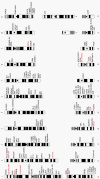Genetics of coronary artery disease and myocardial infarction
- PMID: 26839654
- PMCID: PMC4728103
- DOI: 10.4330/wjc.v8.i1.1
Genetics of coronary artery disease and myocardial infarction
Abstract
Atherosclerotic coronary artery disease (CAD) comprises a broad spectrum of clinical entities that include asymptomatic subclinical atherosclerosis and its clinical complications, such as angina pectoris, myocardial infarction (MI) and sudden cardiac death. CAD continues to be the leading cause of death in industrialized society. The long-recognized familial clustering of CAD suggests that genetics plays a central role in its development, with the heritability of CAD and MI estimated at approximately 50% to 60%. Understanding the genetic architecture of CAD and MI has proven to be difficult and costly due to the heterogeneity of clinical CAD and the underlying multi-decade complex pathophysiological processes that involve both genetic and environmental interactions. This review describes the clinical heterogeneity of CAD and MI to clarify the disease spectrum in genetic studies, provides a brief overview of the historical understanding and estimation of the heritability of CAD and MI, recounts major gene discoveries of potential causal mutations in familial CAD and MI, summarizes CAD and MI-associated genetic variants identified using candidate gene approaches and genome-wide association studies (GWAS), and summarizes the current status of the construction and validations of genetic risk scores for lifetime risk prediction and guidance for preventive strategies. Potential protective genetic factors against the development of CAD and MI are also discussed. Finally, GWAS have identified multiple genetic factors associated with an increased risk of in-stent restenosis following stent placement for obstructive CAD. This review will also address genetic factors associated with in-stent restenosis, which may ultimately guide clinical decision-making regarding revascularization strategies for patients with CAD and MI.
Keywords: Atherosclerosis; Coronary artery disease; Genetics; Genome-wide association study; Heritability; In-stent restenosis; Myocardial infarction.
Figures



Similar articles
-
A genome-wide association study reveals susceptibility loci for myocardial infarction/coronary artery disease in Saudi Arabs.Atherosclerosis. 2016 Feb;245:62-70. doi: 10.1016/j.atherosclerosis.2015.11.019. Epub 2015 Nov 22. Atherosclerosis. 2016. PMID: 26708285
-
Genetic variation in coronary heart disease and myocardial infarction: methodological overview and clinical evidence.Pharmacogenomics. 2000 Feb;1(1):73-94. doi: 10.1517/14622416.1.1.73. Pharmacogenomics. 2000. PMID: 11258599 Review.
-
Strategies beyond genome-wide association studies for atherosclerosis.Arterioscler Thromb Vasc Biol. 2012 Feb;32(2):170-81. doi: 10.1161/ATVBAHA.111.232652. Arterioscler Thromb Vasc Biol. 2012. PMID: 22258900 Review.
-
Molecular genetics of coronary artery disease.J Hum Genet. 2016 Jan;61(1):71-7. doi: 10.1038/jhg.2015.70. Epub 2015 Jul 2. J Hum Genet. 2016. PMID: 26134515 Review.
-
Intravascular ultrasound to guide percutaneous coronary interventions: an evidence-based analysis.Ont Health Technol Assess Ser. 2006;6(12):1-97. Epub 2006 Apr 1. Ont Health Technol Assess Ser. 2006. PMID: 23074482 Free PMC article.
Cited by
-
The Significance of Genetically Determined Methylation and Folate Metabolism Disorders in the Pathogenesis of Coronary Artery Disease: A Target for New Therapies?Int J Mol Sci. 2024 Jun 25;25(13):6924. doi: 10.3390/ijms25136924. Int J Mol Sci. 2024. PMID: 39000032 Free PMC article. Review.
-
Associations of ACE I/D polymorphism with the levels of ACE, kallikrein, angiotensin II and interleukin-6 in STEMI patients.Sci Rep. 2019 Dec 23;9(1):19719. doi: 10.1038/s41598-019-56263-8. Sci Rep. 2019. PMID: 31873176 Free PMC article.
-
Connections for Matters of the Heart: Network Medicine in Cardiovascular Diseases.Front Cardiovasc Med. 2022 May 19;9:873582. doi: 10.3389/fcvm.2022.873582. eCollection 2022. Front Cardiovasc Med. 2022. PMID: 35665246 Free PMC article. Review.
-
Lack of association between the -2549 insertion/deletion variant of vascular endothelial growth factor and coronary artery disease in the Turkish population.Rev Assoc Med Bras (1992). 2024 Nov 11;70(10):e20240333. doi: 10.1590/1806-9282.20240333. eCollection 2024. Rev Assoc Med Bras (1992). 2024. PMID: 39536247 Free PMC article.
-
Meta-analysis of sample-level dbGaP data reveals novel shared genetic link between body height and Crohn's disease.Hum Genet. 2021 Jun;140(6):865-877. doi: 10.1007/s00439-020-02250-3. Epub 2021 Jan 16. Hum Genet. 2021. PMID: 33452914 Free PMC article.
References
-
- Lusis AJ, Fogelman AM, Fonarow GC. Genetic basis of atherosclerosis: part I: new genes and pathways. Circulation. 2004;110:1868–1873. - PubMed
-
- Stokes J, Dawber TR. The silent coronary: the frequency and clinical characteristics of unrecognized myocardial infarction in the Framingham study. Ann Intern Med. 1959;50:1359–1369. - PubMed
-
- Paton BC. The accuracy of diagnosis of myocardial infarction; a clinicopathologic study. Am J Med. 1957;23:761–768. - PubMed
-
- Cybulsky MI. Morphing the topography of atherosclerosis: an unexpected role for PECAM-1. Arterioscler Thromb Vasc Biol. 2008;28:1887–1889. - PubMed
Publication types
Grants and funding
LinkOut - more resources
Full Text Sources
Other Literature Sources
Miscellaneous

